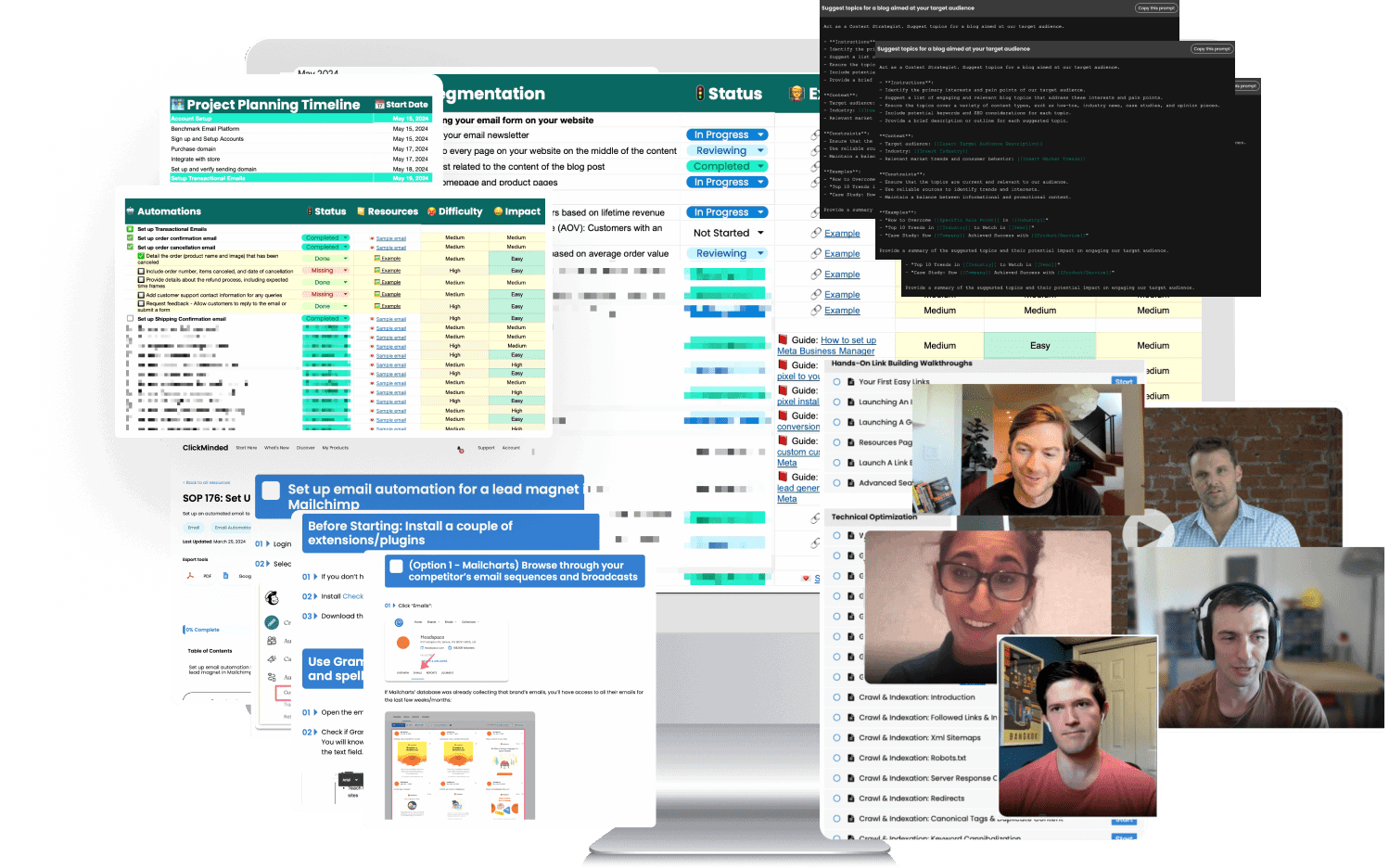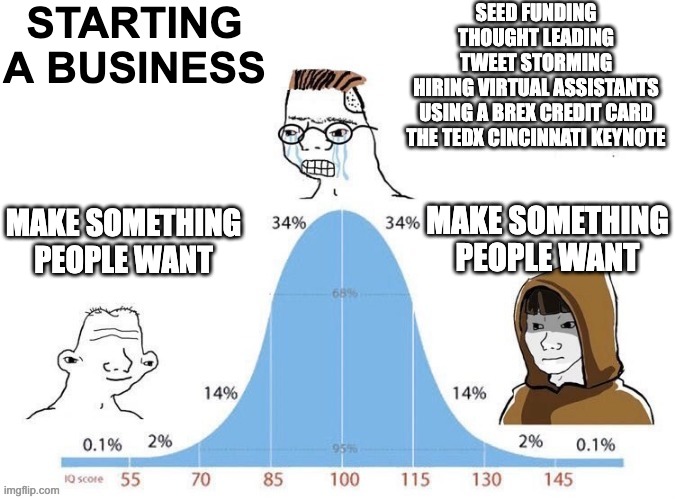
What Is This?
The other day, I asked twitter if anyone would read a blog post like this.
So I decided to do it.
This has become a bit of a tradition here at ClickMinded, where every couple years I basically turn what should be a diary entry into a public post, and just fully expose the business and all the stuff we’ve been working on.
- 2023: Incredibly Difficult and Pointlessly Complicated
- 2019: Burning the Boats: Going All-In on a Side Project
- 2014: A Six-Figure Side Project
- 2012: $21,243 in 8 Days: Why AppSumo Will Keep Crushing It
This post, the one you’re reading now, is the fourth installment of this diary-turned-blog-post experiment.
It takes me about a month to write one of these things, and a few of my friends have asked why I do it.
The honest answer is, I don’t know.
I should probably just download one of those therapy apps and resolve my issues that way instead.
Anyways, let’s get to it.
The Numbers
ClickMinded is a library of digital marketing SOPs, templates and online courses for marketers.
Here are the revenue numbers since the business began back in 2012.
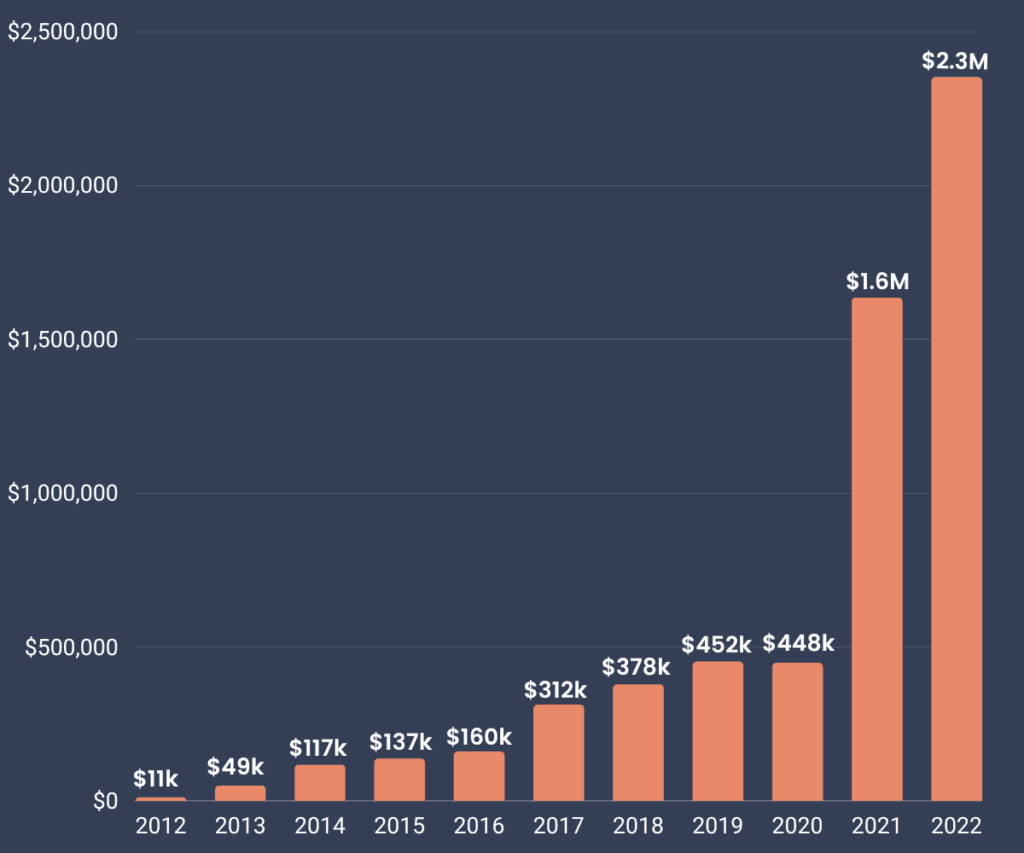
Obviously, the WTF moment was in 2021, when we pivoted from online courses to white-label SOPs (grab our free SOP starter kit if you want to see how they work).
So, what happened in 2021?
The evolution of ClickMinded has been a bit… neurotic. The core “thing” we do has shifted quite a lot:
- 2012: An offline SEO course
- 2013-2016: An online SEO course
- 2017-2021: A library of 7 marketing courses
- 2021-Today: A library of SOPs, checklists & templates
The last time I wrote a post like this, I was full of optimism and excited about what was next. What wasn’t obvious to me at the time, was that we were right in the middle of a 3-year stretch of relatively tepid growth, right before the start of a pandemic.
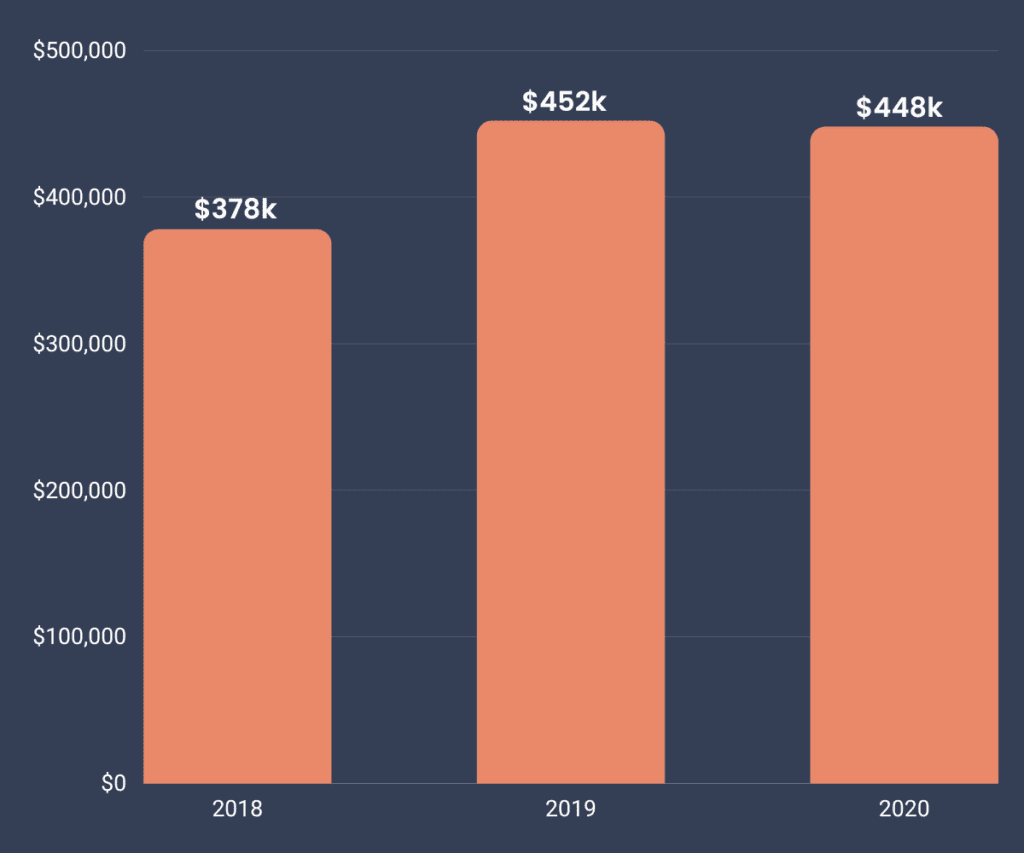
Complicating Everything
We had a ton of ideas around what we should work on next, in order to find another big leg up for our growth.
We had just published a bundle of digital marketing courses that were approved for the course curriculum by some well known universities, and we embedded ourselves into the training process of a few publicly-traded companies.
We had a number of wildly different options in front of us, and multiple paths we could have taken, but the one thing they all seemed to have in common, was that they were all outrageously complicated.
Whenever things went wrong, we rarely questioned whether or not we were making our lives overly difficult for no reason. Instead, we would ignore the root cause of the problem, never address it, avoid simplifying things at all costs, and jump to the next shiny object.
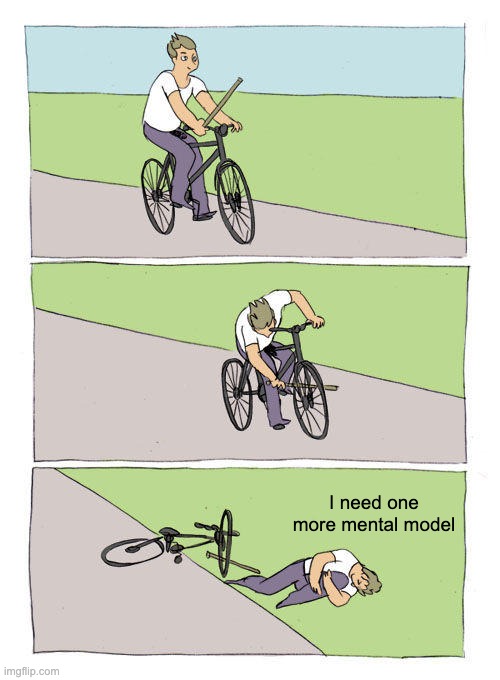
Over 4 years, we spent all of our time and hundreds of thousands of dollars implementing a number of different complicated business models, complicated marketing schemes and complicated management structures.
Complicated BUSINESS MODELS
The “Let’s Do Consulting” phase – We had hundreds of new customers every year, many of them wanted someone else to do the work. Why not consult or build an agency? Turns out, all we had to do was build out a team, book leads and meetings and manage client expectations and projects, then sell our soul and change everything we do from the ground up. Piece of cake.
The “Let’s Sell To Big Companies” phase – Big company budgets. Lots of competitors went in this direction. We read predictable revenue and a hundred other books about SDRs and building a sales team, then developed a complex sales process and had lots of pitch meetings. It only took two years to realize this wasn’t a good idea.
The “Let’s Create Our Own SaaS” phase – The holy grail of monthly recurring revenue. Upsell users to a monthly software product and keep them happy. All you have to do is create an incredible piece of software that stands out from all the other internet marketing tools, keep it updated and relevant and relentlessly battle against the fact that your average user churn is likely 32 days no matter what you do.
Complicated MARKETING
The “Let’s Automate Everything” phase – We created an enormously complicated automated email marketing funnel with a complex scoring system that changed what the user received based on how they interacted with the site. 85 unique, custom emails, delivered to users over the course of YEARS, with different content, offers and variables for everyone.
The “Let’s Have a Webinar For Everything” phase – We did both live and automated webinars, with unique content, instructors, value propositions, price points and promo codes – presented during different days and time zones each week.
The “Let’s Make An Exception For Everyone” phase – A 21-year-old student from Mumbai needs a $7 discount? Make a unique promo code just for him.
The “Let’s Do A Joint-Venture With Everyone” phase – Your friend’s friend has an email list of 232 people? We’d love to work together! We’ll email our list! You email your list! How many emails should we send? Will users get angry if we send 17 unsolicited offers next month?
The “Let’s Pretend We’re a Real Company and Hire A PR Firm” phase – Let’s hire a “real” PR company and get placements in “serious” publications. What’s our narrative? What’s our brand? Do I need to buy a suit? Should I practice that pose crossing my arms while leaning up against a brick wall?
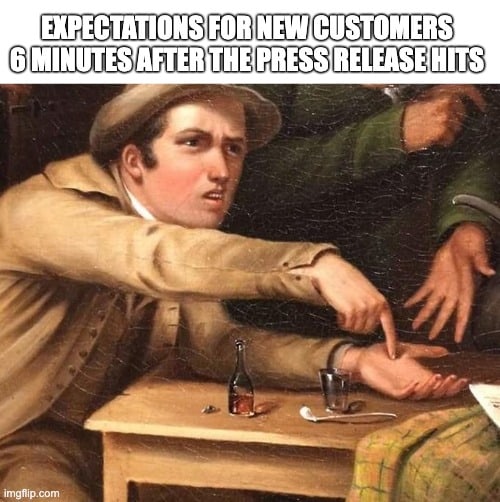
Complicated MANAGEMENT
The “Let’s Offer An Apprenticeship” phase – Let’s hire an apprentice, pay them almost nothing, teach them everything, promote them and then have them run everything. Our last apprentice, Ryan Mason (who’s now the co-founder of Open Advisor, a tax credit comparison tool), was fantastic. He’s now a close friend and went on to do great things, but maintaining an apprenticeship program was much more complicated than just hiring someone who had already done the work previously.
The “Let’s Hire a CEO” phase – Let’s grow the business up to certain point, then hire an “adult” to be the CEO. We’ll do the work until we suck, then find some middle-tier executive from Adobe with 20 years of experience, and have her run everything while we go start something new.
The “Let’s Acquire 10 Other Businesses” phase – Let’s start acquiring websites. We’ll create a model that evaluates traffic, links, revenue, users and overall trajectory, then send out 10,000 cold emails to sites we want to acquire, negotiate with them on an acquisition, then fold those sites and users and traffic into one brand. That doesn’t sound complicated.

The White Knight From Portugal
Our white knight, the guy who saved us from this insanity, was a bearded man from Portugal named André.

The “phases” we went through sound like they could be the natural part of any business’ research and development process, and that might be right. The caveat, however, on why this was such a stupid series of ideas for us, is that we already had a product that users were very passionately telling us they loved, and wanted more of.



If you want to see how it works and why everyone loves it, grab it here:
We also had André, screaming from the rooftops, telling us to shift our strategy and focus on this one area.
We ignored it all.
André had been a part-time member of the ClickMinded team since 2017. He decided to leave home to work remotely while traveling. He started his digital nomad journey like many do – by setting up an Upwork account and taking the first job he could get.
My co-founder Eduardo hired him to do a menial data entry task, which was like bringing a rocket launcher to a gender reveal party – comically unnecessary.

Eduardo realized he had struck gold finding Andre, and held on to him as tightly as he could.
Andre joined and lead the creation of the product we had envisioned – The SOP Library – a massive archive of digital marketing SOPs, templates and checklists that anyone could use to grow their business.
His hyper-attention to detail, along with his genuine, nerdy, passionate interest in the same things that we loved, made him an excellent fit for the product and the team.
We were only his side-piece, though.
His other job took up most of his time, but he told us over and over again that he simply liked the work he was doing at ClickMinded, even if it was only 10 hours a week.
Sunk-Cost Fallacy
The original plan was to use the SOP library as a carrot for our other online course products.
We had decided that we were going to be, first and foremost, an online course company, and we would do promotions that gave users access to our SOP library as a bonus, if they purchased a course.
It worked – but for all the wrong reasons.
We made a mistake, which was that most of our users were buying courses for the bonus product.
Without any promotion and despite being hidden on our site, the SOP library became a successful 6-figure product that was growing every month.
As time went on, André told us to change our strategy and promote everything in a different way. Instead of making it the bonus, we should feature it, repackage it, change the price and put ad dollars behind it.
André knew this, because he had been doing it already for the last few years, running marketing and paid advertising campaigns and growing them to 5, 6, and 7-figure businesses with different products but the same model.
He created the product. He loved the product. He knew the customers, and he had already done this once, successfully, before.
Every time André suggested this, now painfully obvious new strategy, my co-founder Eduardo and I said no.
We had our priorities, our biases and our strong opinions. We wanted to keep things as-is. We wanted to stay focused. No shiny objects! We’re about to have a breakthrough!
This delay, this inability to get out of the way, this commitment to the complicated solution, this refusing to admit that sunk-cost fallacy had completely taken over, was very likely the most expensive mistake we’ve ever made.
Looking back, we were sitting on an incredibly powerful opportunity.
The cauldron was boiling, the ingredients were chopped up and sitting on the counter, and all we had to do was push them into the soup and then get out of the way. And we refused to do it for years.
André’s secret plan was to make everything 10x more simple.
When we finally got out of his way, the results spoke for themselves:
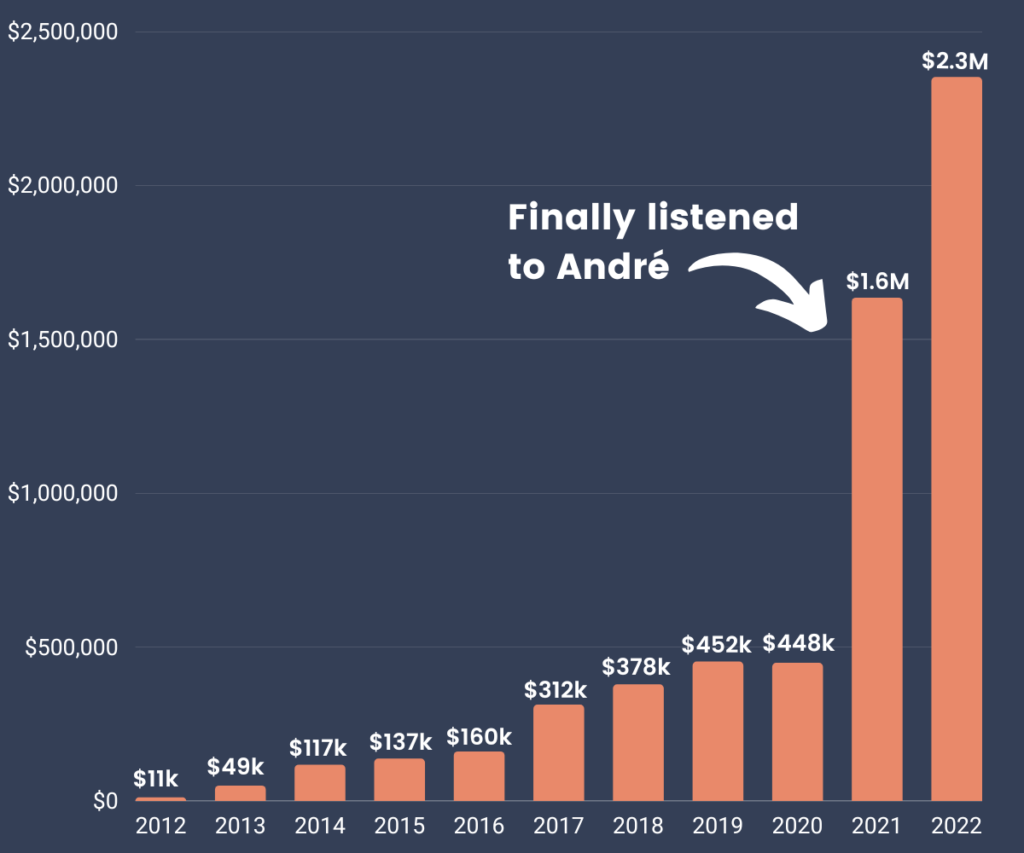
The plan was pretty simple:
Simple BUSINESS MODEL
- Figure out the thing your customers actually want
- Sell them that thing
Simple MARKETING
Our elaborate, 85-email sales funnel, with webinars, mini-course, flash sales and an enterprise sales team, was completely blown away by André’s plan:
- A Facebook ad
- A landing page
- A low cost product that everybody buys
- A higher cost product that some people buy
That’s it.
We also wrestled with how to deliver the product. Our first instinct was, obviously, to make it as painfully complicated as possible:
“We need to create 100 SOPs each for every project management tool: Asana, Notion, Monday, Trello, ClickUp, Trainual and Process Street, hire an engineer to figure out their APIs and then….”
No. Google docs.
- Put everything into Google docs
- Sell access to Google docs
“But!”
Google docs.
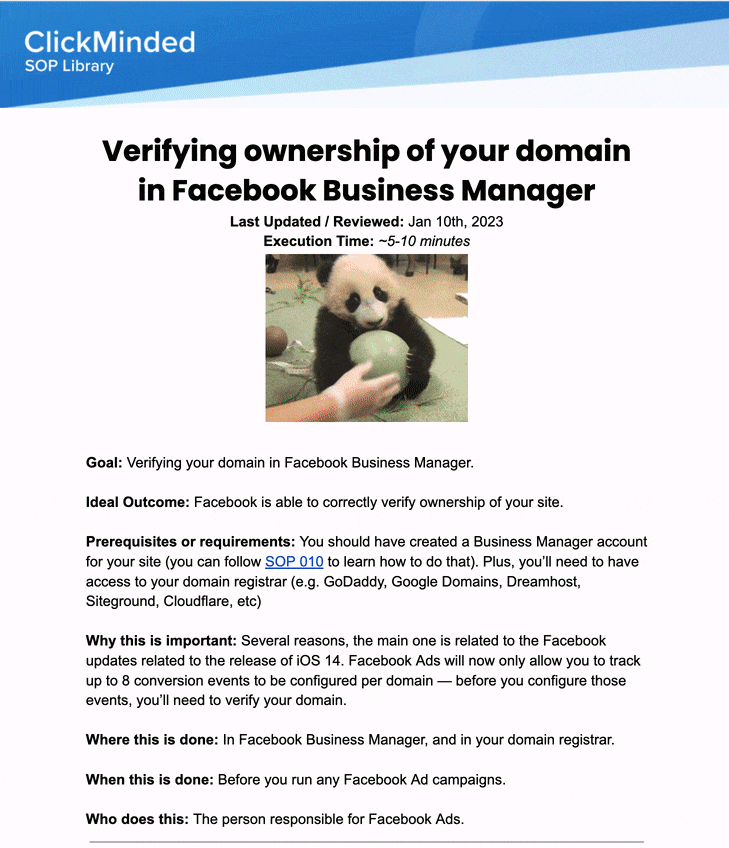
André, the guy we found on UpWork 6 years ago for a data entry job, had launched a paid advertising campaign for our SOP library with a tiny budget.
In his first month, he scaled revenue up to $250,000, and had transformed our business entirely, from a sleepy online training course to a white-label google docs documentation company, in a month.
And he was working 10 hours a week.
Simple MANAGEMENT
I gave Andre the new pitch:
“okay let’s do your thing now.”
The Offer:
- Quit your job
- Be the CEO
- Here’s a bigger salary
- Here’s equity in the business
- We all listen to you now
Andre has been the perfect CEO for the business. He’s significantly better than both Eduardo and myself. He’s incredibly diligent, thoughtful, kind, and a good friend. He has brought some sorely-needed organization and structure to our team, and we love working with him every single day.
It hasn’t all been André, though. David, Sam and the rest of our team have all made major contributions, and I know André would agree that we would not have achieved nearly as much without them.
It’s been fun to watch, because he’s doing so dang well.
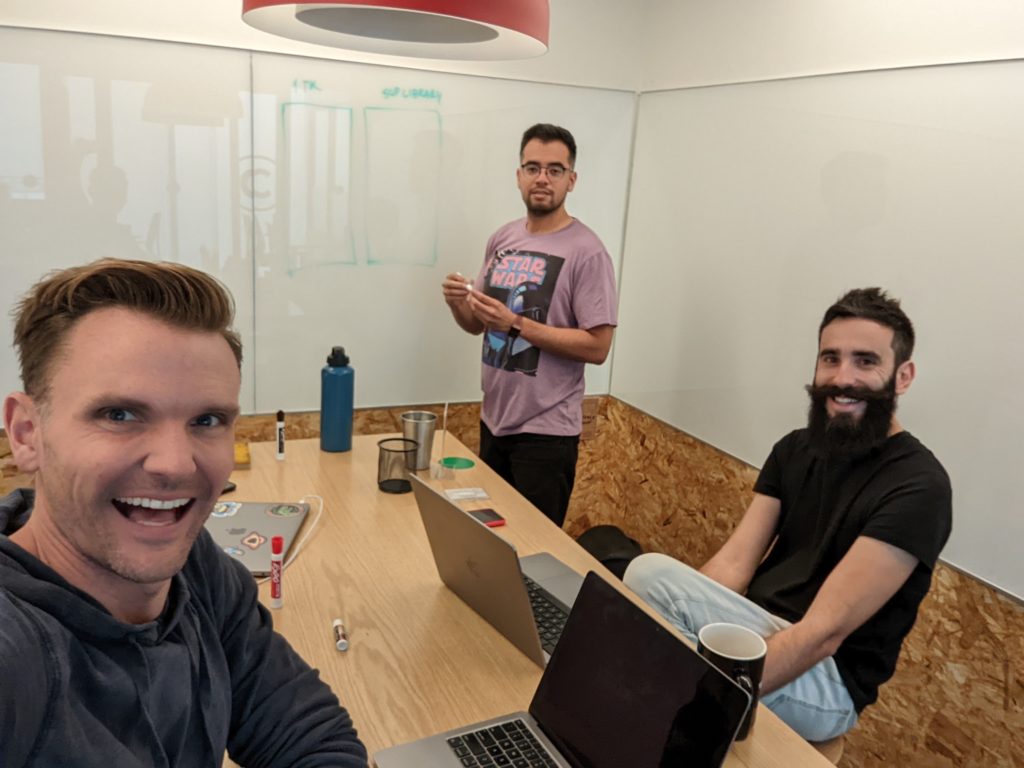
The Bell Curve Of Life
One of my favorite memes is The IQ Bell Curve (also known as the “midwit meme”), which is used to poke fun at people who are average, but think they are smarter than everyone else.
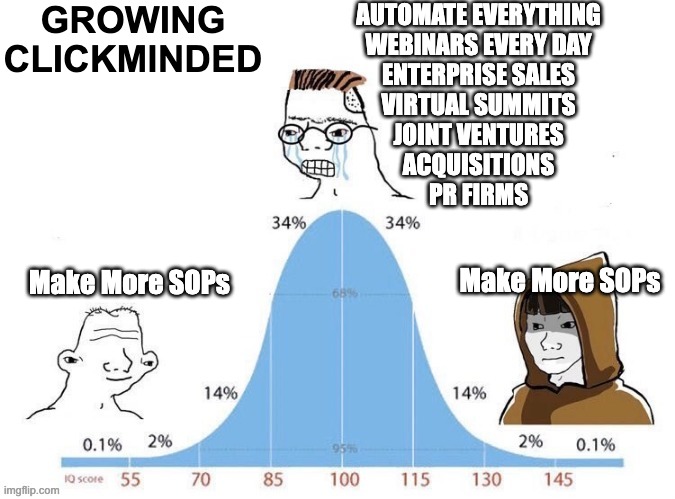
It’s often used to convey that:
- Dumb people use a simple solution because they’re dumb
- Average people use a complicated solution because they think they’re smart
- Smart people use a simple solution because they’re smart
The basic idea is that the low IQ group and the high IQ group come to the same conclusion, even if it’s often for different reasons.
The reason why I love this meme so much, is because it keeps showing up in my own personal life, in so many different categories.




Simple, But Not Easy
Simplifying our business was a massive increase in revenue and efficiency. It was the right move.
With that said, I’ve actually been more fascinated by how frequently I’ve been seeing this trend pop-up in my own life.
Simplifying things has made my personal life significantly better in almost every category. But the reoccurring theme I’ve discovered, is that simple does not always mean easy.
A great example of this comes in the form of two popular, seemingly unrelated books.
The Life-Changing Magic of Tidying Up by Marie Kondo can be summarized in one sentence: Throw away everything you don’t absolutely love.
No Rules Rules by Netflix cofounder Reed Hastings can be summarized in one sentence: Fire all of your B players.
Both of these books, covering completely different topics, are based on simple, 1-sentence advice that you could read while thumbing through them at the bookstore – yet 99% of people are unable to implement these simple, but not easy, ideas.
Throw away everything you don’t absolutely love. Then, once you’re done, you’ll be in love with everything you own.
Fire everyone that’s not an A player. Then, once you’re done, you’ll have a company with only A players.
Simple, but not easy is extremely powerful, and I’ve noticed it showing up in other conventional wisdom as well:
- Your mom’s non-negotiables
- Almost everything has happened before
- Aggressively unsubscribe
- Relentlessly cut your losses
Your Mom’s Non-Negotiables
I have great parents. My mom raised my siblings and I in a very relaxed way. We never really got into trouble. She was generally very hands-off. With that said, there were exceptions, and her lasiez-faire parenting style had some important non-negotiables:
- Brush your teeth
- You’re going to school
- No quitting
The rules were pretty straightforward:
- Every night, you are brushing your teeth. It doesn’t matter what else is happening in the world, you are brushing your teeth.
- Every morning, you are going to school. Doesn’t matter how sick you are, even if it’s just to pickup your homework, you are going to school.
- No quitting. Once you sign up for something, a sport, a club, or any other obligation, you see it through to the end. No quitting.
Sounds simple, but I promise you, not that easy!
Is this all you need to be a good parent? I imagine no. Does this list of non-negotiables even make sense today? Probably not. But the actual list isn’t the point.
The point, is to not let perfect be the enemy of the good.
With the insanity today around premium daycare, Montessori schools and teaching your kid a dozen languages before they turn 5, it’s understandable why so many parents are anxious about being perfect. But your mom wasn’t perfect. And her mom wasn’t either. And you turned out just fine.
There’s ancient wisdom in that simple, smaller list of non-negotiables that your mom had. They weren’t perfect, but they weren’t complicated, either. And they worked – even if Maria Montessori wasn’t involved.
Your mom kept it simple. She didn’t let perfect be the enemy of the good.
Whether it was “eat your vegetables” or “be home before 10”, your mom’s non-negotiables were probably right.
Simple, but not easy.
Almost Everything Has Happened Before
- Principles for Dealing with the Changing World Order by Ray Dalio
- Wanting by Luke Burgis
- Influence by Robert Cialdini
These books, on 3 totally different topics, all arrive at the same basic conclusion: humans are relatively predictable algorithms.
We’ve largely been driven by the same wants and needs, have fallen into the same patterns and have gotten ourselves into and out of the same situations, over and over again, for thousands of years.
Of course there are exceptions, technology breakthroughs and outliers along the way, but in general, our wants, needs and desires are so predictable, that some have been able to use this knowledge for financial markets, marketing copy, trendsetting, motivation and more.
The second layer to this, is that while our wants, needs and desires are relatively simple and predictable, we find ourselves in the middle of an impossibly complex world – placed, whether we like it or not, at the top of a parabolic curve across many categories: population, food, information, technology, medicine and quality of life.
We are living during the climax of the movie.
Even though almost everything has happened before, and even though we are relatively predictable animals, the moment in time that we have been born into is mind-numbingly complex.
Almost everything has happened before.
That makes things simple, but still not easy.
Aggressively Unsubscribe
While our biology is mostly focused on keeping us fed and warm and safe, we find ourselves in a situation where the phone in our pocket tells us when one celebrity slaps another celebrity on the other side of the world, within seconds of it happening.
This is not normal.
We are not wired to successfully participate in the insanity we have created for ourselves, and it’s important to keep this in mind as you go about your day.
When it feels like it’s hard to concentrate, to compete, to eat well and to manage the expectations of others, when it feels like it’s difficult to keep up appearances and to be happy – the reason for that is because you’re right – it’s hard!
The impossibility of the situation we have found ourselves in, is remarkable. The only real solution is to acknowledge how ridiculous it is, and then do the best you can.
This means taking personal responsibility for the role technology and information play in your life, and using it in a way that helps you.
Your attention has a dollar value. Every alert, notification, text message, email and social media post you see has a dollar value. The next time you get an unsolicited message, instead of dismissing it and waiting for it to happen again, imagine that dollar amount being deducted from your bank account.
The only reason why you’re okay with it now, is because the currency you’re spending is your time, not your money.
Stop doing that.
Aggressively unsubscribe, silence, block and uninstall. Take personal responsibility for every message and notification you receive. Go out of your way to prevent unsolicited distractions you didn’t specifically ask for.
Simple, but not easy.
Relentlessly Cut Your Losses
Sunk cost fallacy is the biggest driver of low-quality decisions in my life.
Weapon #2 from Robert Cialdini’s six weapons of influence is Commitment and Consistency, and we see this happening everywhere:
“Once people make a decision, take a stand or perform an action, they will face an interpersonal pressure to behave in a consistent manner with what they have said or done previously”.
Influence: The Psychology of Persuasion, Robert Cialdini
We have a natural tendency to want to be consistent with our past thoughts, feelings, words and actions. It can be quite difficult to break from that pattern. The more invested you are, the more difficult it is to manage sunk cost fallacy.
Cutting your losses is easy with lots of hindsight. It’s easy if you’re a third party giving advice. It’s easy when you have no skin in the game – but when you are emotionally, mentally and financially invested, it’s incredibly difficult to learn to cut your losses – even when it’s the obvious next best move to an outsider looking in.
Relentlessly cut your losses.
Simple, but not easy.
Chasing What You Already Have
One of the best metaphors I’ve found that demonstrates the power of simplifying, is a parable called The Fisherman and the Banker.
The original version is a few centuries old, but the story has had a recent resurgence in popularity, and has been quite useful for me personally:
The Fisherman and the Banker
An investment banker was at the pier of a small village in Mexico, when a fisherman arrived.
The fisherman had caught several large tuna. The banker asked how long it took to catch them.
The fisherman replied, “Only a little while.”
The banker asked “why aren’t you staying out longer to catch more fish?”
The fisherman said he had enough to support his family’s needs.
The banker asked, “but what do you do with the rest of your time?”
The fisherman said, “I sleep late, fish a little, play with my children, take siestas with my wife, stroll into the village each evening where I sip wine and play guitar with my friends. I have a full and busy life.”
The banker scoffed, “I have an MBA from Harvard and could help you. You should spend more time fishing, and with the proceeds, buy a bigger boat. With the proceeds from the bigger boat, you could buy several boats, and then a whole fleet.”
“Once you have a fleet, you could sell directly to the processor, and eventually become your own processor. You would control the product, processing, and distribution. Then you would move to Mexico City, then LA, and eventually New York.”
The fisherman asked, “How long will this all take?”
The banker replied, “15-20 years.”
“But what then?” asked the fisherman.
The banker laughed and said, “When the time is right you will IPO, sell your company stock, and make millions!”
“Millions – then what?” asked the fisherman.
The banker said, “Then you can retire and move to a small fishing village, where you can sleep late, play with your kids, take siestas with your wife, drink wine and strum the guitar with your friends.”
The Fisherman and the Banker is a cute story with a profound conclusion, because it forces you to ask yourself an uncomfortable, potentially life-shattering question:
Is there any chance that you’ve been spending most of your time chasing something that you already have?
The story forces us to ask ourselves “why?” over and over again, in order to get at the root cause of our motivation.
It’s a powerful, but potentially dangerous exercise, because you run the risk of discovering something you might not want to know…
…that you may have already spent a good portion of your time on this planet chasing something that you could already have right now – you just never decided to start having it.
Or, to put it in less agonizing, more productive terms: If not now, when?

So who has it better? The fisherman or the banker?
If the banker just wanted to fish and drink and play guitar with his friends, he’s taking the incredibly difficult and pointlessly complicated route.
But I’m not convinced that the fisherman has it 100% right, either.
They might both be a little bit wrong, because of what I think could be the ultimate driver of happiness:
Maybe we’re not all actually motivated by the car, the house, or even the unlimited time on the beach with friends.
Maybe a more reasonable explanation for what we’re all chasing after, is progress, and the struggle that comes with progress.
Working on something hard, with people important to us, to get to wherever it is we’re trying to go.
If that’s the case, then there’s really only one way to handle it:
- Decide what you want to do with your life
- Try to make measurable progress towards it every day
- Enjoy the struggle
It might be a hobby, a financial goal, a physical goal, an external social achievement or some type of internal dopamine & oxytocin award. Whatever it is that gets you out of bed these days, many smart people seem to be arriving, simultaneously, at the same conclusion:
Making progress and enjoying the struggle, is the root of most happiness.
Simplifying Your Life
Still with me? Let’s wrap this up.
If you’re someone who, like me, is guilty of making your own life incredibly difficult and pointlessly complicated every chance you get, I’m here to tell you that you are not alone. We still have each other.

If you’re interested in finding ways to “not be that guy”, here are a few things I’ve done to simplify my own life. Hopefully a few of them are useful.
Make a Dreamline
This is a little corny, but humor me for a minute.
One of the most valuable things I’ve ever done in my life was create a dreamline.
A dreamline is, very simply, an extremely specific list of your goals, and the date you want to achieve them.
This has been so valuable for me, that I now ask everyone on my team to do one, too. It’s super useful to do this with co-founders, co-workers, spouses, partners, and anyone you’re taking a shared journey with in life.
The key to a good dreamline is hyper-specific, falsifiable goals that have clear lines between success and failure.
- “Get fit this year” is a terrible goal
- “Get to 18.5% body fat by October 18th” is a great goal
Here’s a sample dreamline that you can copy/paste for yourself.
Zoom Out & Ask “Why?” 5 Times
When you’re stressed or spinning your wheels, asking yourself “why?” 5 or so times, will solve an enormous number of your problems.
If you’ve completed your dreamline, and you were incredibly specific about your goals, zooming out and asking yourself “why?” in stressful situations almost always brings you to the same conclusion:
“This thing I’m stressing out about right now, doesn’t matter.”
You can use this tactic to be more stoic in your day-to-day life. It helps you realize that the little inconveniences that make up your day are minutia that should mostly be ignored.
Asking yourself “why?” 5 times will prevent you from stressing out about the dumb stuff, but, just like the fisherman and the banker, it also keeps you from over-optimizing.
Get Out Of The Way
I’m now 10 years into my business, and one of my most valuable contributions, is doing nothing.
If you are running a company or a team, and a lot of the process, culture, behavior and the overall vibe is built around you and your personality, I highly recommend running an experiment on getting out of the way.
You don’t always have to have an opinion. You don’t have to always be the main character. It doesn’t always have to be about you.
Try getting out of the way.
Copy/Paste As Much As Possible
Almost everything has happened before. There’s almost always someone out there who has done what you are trying to do. It is almost certain that the thing you need already exists.
Don’t re-invent the already invented. Copy and paste as much as reasonably possible.
That’s exactly why our business has exploded – because we leaned into the idea that most people have the same problems over and over again. That’s why we created and curated all the most important SOPs, checklists, templates and processes for marketing teams and agencies.
If you’re trying to add repeatable processes to your business that you can copy/paste, our free SOP starter kit has everything you need to get going.
Conclusion
Yikes. That was a windy road.
Writing all your thoughts and feelings down in a blog post like this probably isn’t the easiest way to resolve issues. I guess I still haven’t fully figured out how to avoid the difficult / complicated path, 100% of the time.
The internal battle continues.

Probably still need to go to therapy.
I’m still deciding what the ultimate conclusion is here. Perhaps there are multiple conclusions, and I think it might also be open to interpretation.
The one idea I feel truly confident about, though, is the presumption that your happiness is closely tied to your demonstrable progress.
The best way I’ve seen this described, is thinking about your life as a single-player vs a multi-player game.
We’re led to believe that life is a multi-player game. We’ve been programmed to think that there is some kind of all-knowing global eternal scoreboard, and we’re all convinced that we need to be #1 at whatever it is we’re working on.
The reality, is that everything is a single-player game. The only competition is you vs you, and the only score is demonstrable progress towards a personal goal, measured against yourself. No one else.
How simple, uncomplicated, and awesome, is that?
You don’t need to be the best in the world, but you can probably get 100x better than you are right now, at whatever it is you’re trying to achieve.
That’s actually possible.
How insane is that? 100x better!
That’s amazing! And totally achievable.
But is that really it? Is the secret to happiness really just simplifying everything and focusing on making progress towards some goal?
That sounds too simple. I doubt it’s actually that straightforward.
I’ll probably start with all of the incredibly difficult and pointlessly complicated options, first.
